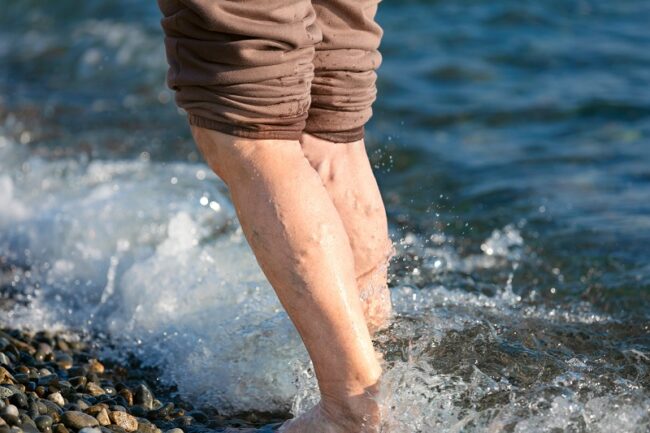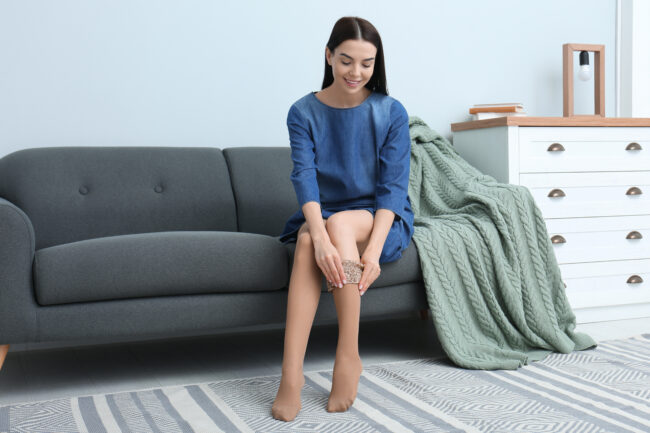There’s nothing like an Australian summer to get us visiting the beach, enjoying bushwalks, or going out to enjoy the warm evening air. Even though many of us enjoy soaking up the rays, swollen, veiny legs can often stand in the way. For those with the condition, here are some tips for dealing with varicose veins in the summer.
Why do varicose veins get worse in the summer?
Warm summer weather warms your body. In response, your body then tries to cool off by dilating the vein walls. As the vein walls dilate, more blood runs through them, and it becomes even harder for damaged vein valves to close. As varicose veins expand further and the strain on them increases, associated varicose vein symptoms of cramping, swelling, and aches may worsen.
How can I manage varicose veins in the heat?
Keep cool

man with varicose veins in his legs standing in the water at the beach to cool off.
Keep the legs cool during hotter days. You can do so by taking a dip in the pool or swimming at the beach, sticking to air-conditioned spaces, or enjoying a relaxing nap in a cool room.
If your varicose veins are particularly bothersome at night, it’s important to take steps to cool down the room you sleep in through air con. Alternatively, you can find a cooler spot in your home to rest (for example, a downstairs guest room, since heat rises). Some other tips include sleeping in a wet shirt, creating flow-though if there’s a nice breeze outside, and drinking some ice water before bed.
Wear the right shoes
Footwear has a distinct effect on the circulation in your legs, and tight and high-heeled shoes aren’t a good fit for the summer. That’s because tight shoes make it harder for your blood to flow into and out of your feet, while high heels stop your calves from moving properly, thus making your veins work overtime. This strain, combined with the stress of hot weather, can worsen your symptoms. So try to wear properly fitting shoes, and opt for a lower, thicker heel.
Get physical
Regular exercise is one of the best ways to manage varicose veins. While keeping active in the summer can be tricky with the sun blaring down, there are a few ways to get around it.
- You can always go for a swim in cooler water. We recommend doing so before 11 a.m. or after 3 p.m. to avoid the sun’s peak heat.
- Go on morning and evening walks when the sun isn’t out or just starting to rise.
- Walk around your local air-conditioned shopping centre
- Do gentle exercises in an air-conditioned room or gym
- Take an indoor yoga or Pilates class
Compression

Woman sitting on her couch pulling on compression socks
Wearing compression stockings is one of the best ways to manage swollen legs and varicose veins, especially on hot days. Bauerfeind’s range of compression stockings is made from a breathable and comfortable fabric that stays cool, so you can wear them in summer, winter or any other time of year.
In particular, VenoTrain Cocoon has a special moisturising weave to keep the skin from drying out, so it stays cool and hydrated in the summer heat.
Slip, slop, slap
Varicose veins are particularly sensitive to UV rays. So, stick to the shade, slip on light, protective clothing, slop on a healthy coat of sunscreen, and slap on a hat.
Hydration
Staying hydrated is already an important habit in summer, but it’s especially crucial for your vein health. Drinking plenty of water will thin your blood, making it easier for it to travel around your veins. Not to mention, it will help keep you from overheating.
How can I reduce the appearance of varicose veins in the summer?
Although varicose vein appearance should be a secondary concern behind symptoms, we know these bulging veins can affect self-esteem, especially when you can’t cover them up due to the heat. Applying foundation or concealer is one way to reduce varicose vein appearance especially for special occasions. However, you should also note that due to the bulging nature of varicose veins, makeup may not be as effective in covering up protrusions on the skin. Simultaneously, applying too much pressure on them may lead to rupture. Therefore, if you really need to apply makeup, do it gently on the skin.
Seek treatment
Boosting your circulation, wearing compression, keeping cool, and covering up are all good ways to reduce varicose vein symptoms and appearance, but these are only temporary fixes. The most surefire way to avoid dealing with varicose veins in the summer is to treat them in the winter or spring. Not only will treatment save you a lot of aches, but it will also give you summer-ready legs.
So, if you’re ready to take the next step, call us at 13 VEINS (13 83467) or make an enquiry via the Contact Us page.

